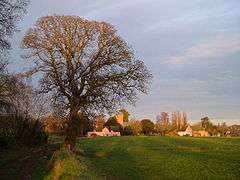Cheddon Fitzpaine
| Cheddon Fitzpaine | |
 A view of Cheddon Fitzpaine |
|
 Cheddon Fitzpaine |
|
| Population | 1,929 (2011)[1] |
|---|---|
| OS grid reference | ST242276 |
| District | Taunton Deane |
| Shire county | Somerset |
| Region | South West |
| Country | England |
| Sovereign state | United Kingdom |
| Post town | TAUNTON |
| Postcode district | TA2 |
| Dialling code | 01823 |
| Police | Avon and Somerset |
| Fire | Devon and Somerset |
| Ambulance | South Western |
| EU Parliament | South West England |
| UK Parliament | Taunton Deane |
Coordinates: 51°02′35″N 3°04′53″W / 51.0431°N 3.0814°W
Cheddon Fitzpaine is a village and civil parish in Somerset, England, situated on the Quantock Hills 2 miles (3.2 km) north of Taunton in the Taunton Deane district. The village is situated near the Bristol and Exeter Railway, the Bridgwater and Taunton Canal, and the River Tone and has a population of 1,929.[1]
History
Flint and pottery uncovered during archaeological excavations demonstrate late Neolithic to early Bronze-age and Romano-British settlement sites near Maidenbrook and Nerrols. The name of the village was "Cedenon" probably meaning "wood valley" in 897. After the Norman Conquest it was granted to Roger Arundel and was then passed down through his family. The parish of Cheddon Fitzpaine was part of the Taunton Deane Hundred.[2] In the 16th century the manor was bought by Thomas More of Taunton Priory.[3]
Governance
The parish council has responsibility for local issues, including setting an annual precept (local rate) to cover the council’s operating costs and producing annual accounts for public scrutiny. The parish council evaluates local planning applications and works with the local police, district council officers, and neighbourhood watch groups on matters of crime, security, and traffic. The parish council's role also includes initiating projects for the maintenance and repair of parish facilities, as well as consulting with the district council on the maintenance, repair, and improvement of highways, drainage, footpaths, public transport, and street cleaning. Conservation matters (including trees and listed buildings) and environmental issues are also the responsibility of the council.
The village falls within the Non-metropolitan district of Taunton Deane, which was formed on 1 April 1974 under the Local Government Act 1972, having previously been part of Taunton Rural District.[4] The district council is responsible for local planning and building control, local roads, council housing, environmental health, markets and fairs, refuse collection and recycling, cemeteries and crematoria, leisure services, parks, and tourism.
Somerset County Council is responsible for running the largest and most expensive local services such as education, social services, libraries, main roads, public transport, policing and fire services, trading standards, waste disposal and strategic planning.
It is also part of the Taunton Deane county constituency represented in the House of Commons of the Parliament of the United Kingdom. It elects one Member of Parliament (MP) by the first past the post system of election, and part of the South West England constituency of the European Parliament which elects seven MEPs using the d'Hondt method of party-list proportional representation.
Geography
Gadds Valley is an area of open grassland and woodland, which has been designated as a local nature reserve.[5]
Landmarks
Pyrland Hall was built as a country house around 1760 for Sir William Yea and later became a boys preparatory school.[6]
The nearby Hestercombe House and Gardens includes gardens designed by Sir Edwin Lutyens.[7] Its restoration to Gertrude Jekyll's original plans (1904–07) have made it "one of the best Jekyll-Lutyens gardens open to the public on a regular basis",[8] visited by approximately 70,000 people per year. The estate is Grade I listed on the English Heritage Register of Parks and Gardens of Special Historic Interest in England.[9] The site also includes a 0.08 hectare biological Site of Special Scientific Interest as it is used as a roost site by Lesser Horseshoe Bats and has been designated as a Special Area of Conservation (SAC).[10] The house was used as the headquarters of the British 8th Corps in the Second World War, and has been owned by Somerset County Council since 1951. It is used as an administrative centre and is the current base for the Somerset Fire and Rescue Service control room.
Religious sites
The Anglican parish Church of St Mary has a 13th-century tower and 15th century nave.[11] The Old Rectory near the church was built around 1861, possibly by Edward Jeboult and later turned into 3 dwellings.[12]
References
- 1 2 "Statistics for Wards, LSOAs and Parishes — SUMMARY Profiles" (Excel). Somerset Intelligence. Retrieved 4 January 2014.
- ↑ "Somerset Hundreds". GENUKI. Retrieved 21 October 2011.
- ↑ Bush, Robin (1994). Somerset: The complete guide. Wimborne, Dorset: Dovecote Press. p. 64. ISBN 1-874336-26-1.
- ↑ "Tainton RD". A vision of Britain Through Time. University of Portsmouth. Retrieved 5 January 2014.
- ↑ "Gadds Valley". Natural England. Archived from the original on 4 March 2016. Retrieved 23 August 2015.
- ↑ "Pyrland Hall". Images of England. English Heritage. Retrieved 2008-12-09.
- ↑ "Welcome to Hestercombe Gardens". Hestercombe Gardens. Retrieved 2006-11-27.
- ↑ GardenVist.com: Somerset.
- ↑ "Hestercombe Gardens" (PDF). European Garden Heritage Network. European Garden Heritage Network. Retrieved 2008-12-09.
- ↑ "Hestercombe House". Joint NatureConservation Committee. Retrieved 2007-03-03.
- ↑ "Church of St Mary". Images of England. English Heritage. Retrieved 2008-12-09.
- ↑ "The Old Rectory". Images of England. English Heritage. Retrieved 2008-12-09.
External links
![]() Media related to Cheddon Fitzpaine at Wikimedia Commons
Media related to Cheddon Fitzpaine at Wikimedia Commons
